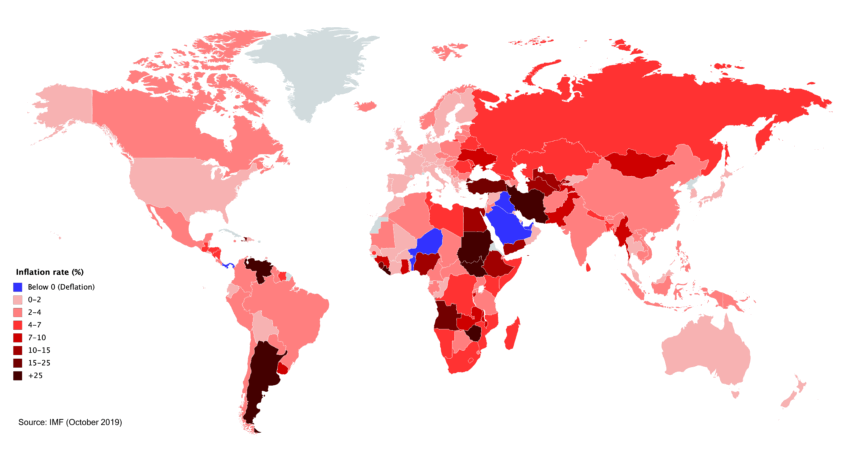The April numbers of inflation were good. Producer prices dropped. Retail sales are flat. Many even claimed that inflation is cooling.
The real story often lies in the small details. We’re not seeing relief but rather the beginning of something more difficult to measure, and therefore much more telling.
Tariffs have finally kicked in and yet the price shock is still a long way off.
How does US inflation look for the remainder of 2025?
Prices really dropping?
US Producer Prices fell 0.5% in April. According to Bureau of Labor Statistics, this was the largest monthly decline since the pandemic’s early days and a much greater drop than economists expected (0.2%).
This looked on the surface like progress made in fighting inflation. This wasn’t the case.
This was mainly due to the decline in margins for trade services. This is the difference between what businesses earn at wholesale and retail.
The 1.7% decline in this category indicates that companies will continue to absorb higher costs and not pass them onto consumers.
The core PPI (excluding food, trade and energy) also fell by 0.1%.
The rise in goods prices was 0.4% (excluding energy and food), the highest increase since more than two year.
The businesses pay more for the materials to produce their products, but haven’t raised prices yet. This can’t continue forever.
Why do retailers hold back?
The retailers aren’t blind. They’re preparing. Sales in March jumped by 1.7%, as customers rushed to purchase before Trump’s new tariffs went into effect.
Retail sales in April barely changed, increasing by just 0.1%. Seven of thirteen categories, however, fell. The control group sales that feed into the GDP fell by 0.2%.
The consumers react to what is expected and not on what has already been seen. This is a major difference. It took several months in 2018 for tariffs on washing machines to increase the price.
The reaction this time is quicker. Inflation has changed in psychology. The psychology of inflation has changed. They’re now slowing down.
Walmart has confirmed that it will begin raising its prices in the next few weeks. The first to be affected will include electronics, toys, and some imported foods. This move will have a major impact on the retail industry. Walmart will not be able to keep prices low if smaller retailers can’t.
What is the Fed watching for?
Federal Reserve chair Jerome Powell stated this week that the economy could be moving into a phase of increased supply shocks.
This means that inflation will not follow a straight path. The swings will be more abrupt and unpredictable.
He said that the inflation rate “could become more volatile in the future than it was during the period between the two crises of 2010.”
Tariffs cause supply shocks, and the Fed is aware of this. Tariffs increase costs at entry points, then filter down to manufacturers and retailers. They only appear in the CPI after a long delay.
While CPI was soft in April and the core PCE will likely remain near 2,9%, there are already signs that inflation is going to rise later this year.
The markets still anticipate that the Fed will cut rates during its next meeting in June. These cuts, however, are based not on the future but on how things currently look.
The Fed may be forced to stay the course on rates or even stop them altogether if inflation rises in June and July. This would surprise both the markets and consumers.
What are the reactions of companies?
It is not a theoretical issue. The data is there. Manufacturers and retailers are changing their strategies in a quiet manner. Some retailers are increasing prices.
Some companies pull entire product lines because they are too costly to be profitable. Some companies are changing their sourcing strategy or relying more on their suppliers.
Walmart has greater flexibility because it imports only 15% of their products from China. It also sells a lot more groceries in the United States.
It couldn’t wait forever. The CEO of the company said that the tariffs were “too expensive” and they couldn’t afford to pay them any more.
The same decision is being made by other companies such as Target, Mattel, and Home Depot. Trump’s tariffs are both a cost to the economy and a political minefield.
Amazon was threatened when it considered adding the cost of tariffs to product pages.
Walmart, which usually is careful in its political comments, has openly criticised the tariffs.
What do the numbers really mean?
The squeeze has begun. The margins of companies are being squeezed. Customers are on the defensive before price increases.
Prices of goods, particularly imported ones, have been creeping upwards. The inflation rate for services is low, but this may change if wages continue to grow and demand for travel returns.
CPI and PCE headlines do not show the full picture of inflation. It’s already visible in the core goods categories, and earnings reports of corporations.
We’ll know the results of consumer reports in two to three month if data is valid.
US Inflation 2025 Outlook: What can we expect?
The inflation rate in 2025 will be accelerated. The drop in producer prices was due to the impact on businesses. This is only sustainable for short periods of time.
Now, the timeline looks as follows:
May-June: Retailers begin raising prices. Walmart and other retailers implement price increases on certain tariffed goods.
From June to July, CPI starts reflecting higher prices for consumer goods. The core inflation rate ticks up.
From July to September: As pass-through increases, margin compression is reduced. Fed reviews its path for adjusting rates. The market’s expectations of rate cuts start to change.
Price increases will not be huge at first. The price increases will be visible in certain categories, such as electronics, toys and appliances.
The direction of travel will become clear. The inflation isn’t falling. The short-term buffer is just delaying it.
Walmart is the “canary of coal mine”. By mid-June, we can expect more retailers to follow.
The future is unpredictable. The volatility of inflation will rise if tariffs change. The consumer will continue to adjust their expectations more quickly than the models can.
The Fed will have to prove its ability to make policy decisions based on data that is a step backwards, more so than any time since 2022.
Prices are stable for the moment. The system, however, is in motion. Before we can see the story clearly, inflation will already be changing.
The post Inflation forecast in 2025 – what soft data from April is not telling you could be updated as new information becomes available.
This site is for entertainment only. Click here to read more






